
|   |

|   |
 e-mail: ukb7@rediffmail.com Sparks of passion May 9, 2017 Kandyan dance, originally performed by dancers who were identified as a separate caste under the Kandyan feudal system - aligned to the 'Temple of the Tooth' and with a significant role to play in the dalada perahera (procession) held each year by the local temple - waned gradually in popularity as the support for the dancers from the Kandyan kings ended during the British period. Now revived and adapted for the stage, Kandyan dance is reckoned as part of Sri Lanka's prime cultural heritage today. 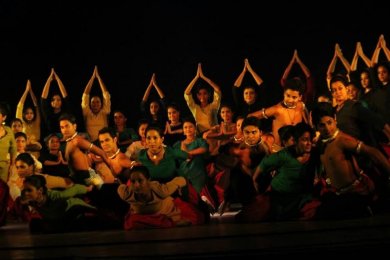
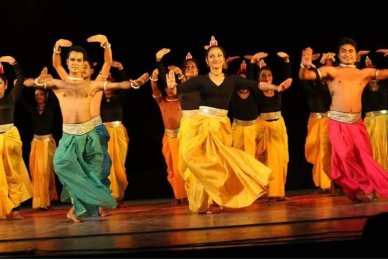
Kandyan dance workshop participants
Under UNESCO's laudable vision prevailing over a decade, there is no better means than dance for vividly illustrating cultural diversity and embodying rapprochement among communities and nations. As the ideal means for bringing together people from different countries, there could have been no better initiative, therefore, for the West Bengal Dance Group Federation than to celebrate the World Dance Day 2017 by presenting participants of a workshop under the eminent Kandyan choreographer Buddhi Edirisinghe from Sri Lanka. Buddhi's opening overture, Threevidha Rathna, was an illuminating solo. Steeped in the Pali hymns - which continue to resonate the island's Buddhist ethos, in contrast to Pali's near disappearance from this sub-continent - it underlined the triple tenets of Buddha, Dhamma and Sangha, with her elephant-like gait encircling a focussed centre, to point towards Nirvana (salvation). Ridma Angahara came next, based on Indian rhythms composed by Bickram Ghosh. Danced by the workshop participants, it illustrated intricate footwork, body movements and hand gestures, combining the feminine softness with the male virility. Third was Mayura Ridma, a peacock dance solo by Buddhi, with traditional Kandyan visualization of the bird's movements. The last was Narilatha by the workshop participants again, delicately poised on a Sri Lankan folk song, woven around a Himalayan flower, its fragrant beauty and the flight path of the honeybee seeking its nectar. The main presentation schedule was crafted by as many as 17 dance groups of West Bengal. While their passion for dance was palpable, their overall competence, individual skill-level and total choreography varied from the mere gestation, through a refreshing articulation, to a happy culmination: tentatively rated by this critic on a sliding scale of one-two-three. Whatever the outcome, it was an amazing all-round effort, considering that the average age of the participants veered very much on this side of twenty! 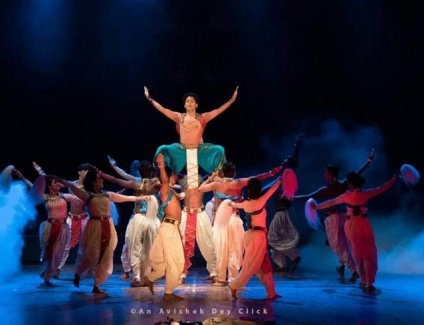 Abantipur Om Foundation 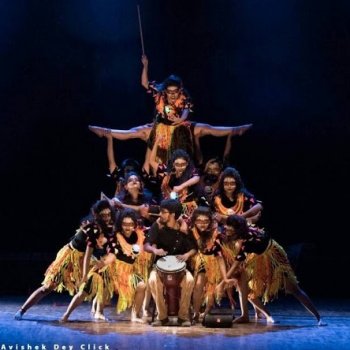 Subhangik 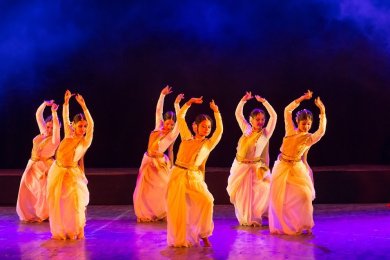 Udayan Kalakendra 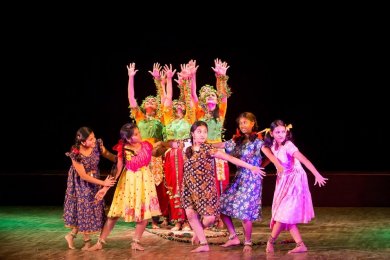
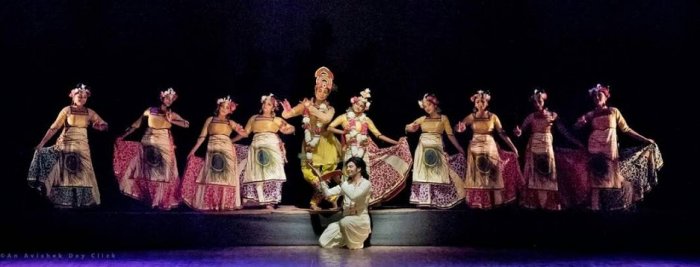 Brahma Kamal The program was touched off by 'Srijan Shobha', an NGO, with specially abled children, dancing valiantly to two songs: I am quizzed by the blue lodestar... and I desperately seek a friend... (no grading). Second came 'Krishti Srirangam' dancing with Bratati Bandyopadhyay's recitation and Srabani Sen's melody interlaced in Tagore's lyric: I call her the dark bud, though she is dubbed the black one by village folks...(two). Third was 'Trintini' depicting young children's innocent pranks and games, hailing from both sides of East and West Bengal (one-two). Fourth came 'Belur Nrityangan Shiksha Kendra' dancing - with beautiful geometrical formations - to a later paragraph of the national anthem's lyric, sung soulfully by Kabeer Suman and Kaushiki Chakrabarty (three). Fifth was 'Chhandam', depicting stark contrasts - between black and white, between beauty and the beast - that brought forth anguish and angst to one and all (one-two). Sixth was 'Parampara' questing for peace following the guiding beacon of divinity (one). Seventh came 'Garden Reach Nikkon Nrityabitan', interpreting in Odissi style the keertan, Haririha, from Vaishnava Padvali (two). Next was 'Sonarpur Nadam' blending skillfully Kathak with the Jhumur folk song rendered well by Dohar (two-three). Ninth was an absolute delight by 'Udayan Kalakendra' using Uday Shankar's idiom to create celestial Apsaras in the heavenly court of Indra, in resplendent white attire and in a very judicious blend of speed and pause (three). Tenth was a 'Belur Shinjini' presentation, choreographed by Buddhi, to depict graphically existence of tortured human souls as distinct from liberated spiritual beings (two-three). Eleventh came 'Kalapi' to show youth brigade's courageous effort to save flower gardens from the hackers and marauders - inspired by Chipko movement - set to a song, The handkerchief of jasmine blooms (three). Twelfth was a lacklustre 'Brahma Kamal' dance composition based on Jayadeva's Gita Govinda (one-two). Thirteenth came 'Nritya Kalangan' showcasing a lively demonstration of Bharatanatyam adavus to: om dhi thom nam... (two-three). It was followed by 'Abantipur Om Foundation' putting up vividly, from Mahabharata, its principal character Yudhisthira's lifelong confrontation with warped principles and predicaments from a modern angle (three). Fifteenth was 'Nrityoday' doing a contemporary jig on the popular song by Lagnajita, The spring has arrived... (two-three). The penultimate item by 'Shubhangik' was the rather contrived tale of a plane-crash survivor encountering a secluded jungle tribe who traipsed to his bongo-beats (one). The finale was "Hritaal' interpreting boisterously a popular ditty by Lopamudra Mitra, Let the mind fly away...(two-three). Ably steered by Chandrodoy Ghosh, the celebration did ample justice to the World Dance Day's many dicta: "Festivals promote in the most lively manner reciprocal knowledge and respect of diversity... Hundreds attend dance festivals each year... Teachers offer classes to provide immediate bridges of understanding ingrained into the bodies of dancers..." 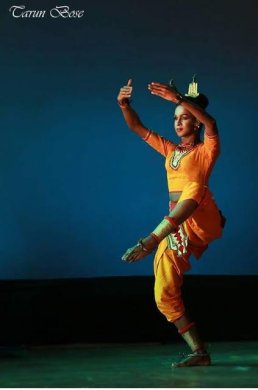
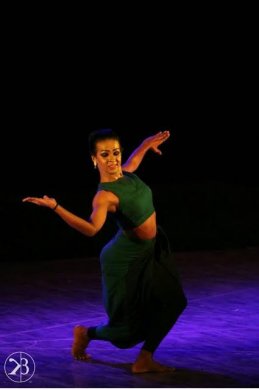
Buddhi Edirisinghe
Extracts from interview with Buddhi Edirisinghe: How ancient is the Kandyan dance tradition in Sri Lanka? Its roots are indeed steeped into antiquity; some even believe it to be two millennia old. Its present-day revival is entirely due to efforts put in by Chitrasena who - after Tagore's visit to Sri Lanka - came to Santiniketan in 1934 and participated in the poet's dance-drama Shapmochan (Redemption of the Curse). The dance form is very popular today. How defined is its grammar? It is a very refined form of dance, most of which is carried through orally. There are no masks, but headgears are aplenty. Mudras (hand gestures) don't carry specific meanings. It has been a male-oriented vigorous dance, till Chitrasena's wife, Vajira, introduced feminine elements. I've learnt the form from their eldest daughter Upeka since childhood. What are its links with Indian classical dances? Interestingly, there is very little similarity to Bharatanatyam, though there seems to be many connections with Odissi. I am planning to do a Ph.D. under Sujata Mohapatra. After Chitrasena's fruitful stay in Kerala, he introduced many Kathakali elements as well into his dance which suited its masculine propensity. How has its choreography evolved? Buddhism is very strong in Sri Lanka and its teachings as well as the Pali literature have had a strong influence on its evolution. There are about 18 forms of animal movements incorporated in the dance, including those of elephants, peacocks and others. Masculine stances are freely intermingled with the feminine ones today. What's your experience of the Kolkata workshop? It was an 8-day workshop with two daily sessions: 2 to 3pm and 3.30 to 6.30pm. There were 90 participants, all of whom were trained dancers with backgrounds in Bharatanatyam, Odissi, Creative or Uday Shankar styles. I used pre-recorded music. The result has been mutually most satisfactory.  Dr. Utpal K Banerjee is a scholar-commentator on performing arts over last four decades. He has authored 23 books on Indian art and culture, and 10 on Tagore studies. He served IGNCA as National Project Director, was a Tagore Research Scholar and is recipient of Padma Shri. Post your comments Please provide your name and email id when you use the Anonymous profile in the blog to post a comment. All appropriate comments posted with name & email id in the blog will also be featured in the site. |